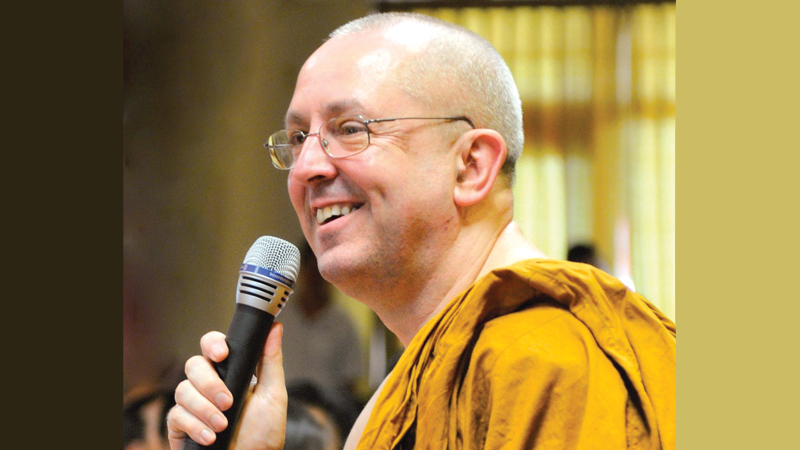In a recent meditation class, renowned Buddhist bhikkhu Ajahn Brahm (Ajahn Brahmavamso) shared profound insights on overcoming one of meditation’s most persistent challenges: the thinking mind. Drawing from years of teaching and personal meditation experience, Ajahn Brahm introduced practical techniques to help meditators detach from their thoughts and access a deeper, more peaceful meditative state.
The essence of meditation
Ajahn Brahm began by reminding participants that meditation is meant to be a peaceful, effortless process. He said that many people struggle with meditation because they approach it with too much effort, leading to frustration and discomfort. He emphasised that relaxation—of both the body and mind—is the foundation of successful meditation. “The key,” he said, “is to observe without interference, to simply be aware without engaging in the mental chatter.” Meditation, he added, is about learning how to relax and watch without doing anything, allowing the meditator to distance themselves from their thoughts and create the peacefulness meditation promises.
The problem of overthinking
Ajahn Brahm addressed one of the greatest challenges in meditation: the mind’s tendency to overthink. Thoughts frequently intrude, making it difficult for meditators to find the stillness they seek. He used a powerful metaphor, comparing overthinking to getting lost in a movie in a cinema. “When you’re caught up in a movie, it feels so real that you might forget it’s just a film,” he said. Similarly, thoughts can dominate our minds, making them seem more important than they really are. Drawing from his book Opening the Door of Your Heart, Ajahn Brahm shared a humourous anecdote about a drive-in theater in Jamaica where patrons would shoot at the screen during violent scenes, forgetting that the events were only happening on film. This, he explained, is how we react to our thoughts—mistaking them for reality instead of recognising them as mere mental projections.
Creating distance from thoughts
Ajahn Brahm introduced a powerful visualisation technique to help meditators create distance between themselves and their thoughts. He suggested imagining thoughts as though they were playing on a screen in front of the observer. By mentally stepping back and observing from a distance, meditators can gain a healthier perspective on their thoughts. “When you stand back and look at your thoughts as if on a screen, you realise you are not the thoughts,” Ajahn Brahm explained. This separation fosters a sense of calm, allowing the thoughts to fade away naturally without emotional involvement.
The illusion of thought
Ajahn Brahm emphasized that thoughts are often not the best source of wisdom. “Thoughts just give you more questions and more arguments,” he said. True understanding, he added, often comes from silence rather than mental chatter. Drawing on ancient spiritual wisdom, Ajahn Brahm highlighted that many traditions teach that real insight emerges from stillness. He used a vivid analogy from a popular Lunig cartoon, where a family watches a sunset on TV while ignoring the real sunset outside their window. This, he said, mirrors how we often experience life—through the filter of our thoughts—rather than fully engaging with reality. Naming and labeling our experiences, he pointed out, reduces their beauty and essence.
Practical benefits of overcoming thoughts
Ajahn Brahm’s meditation teachings are not just limited to the meditation cushion; they offer practical applications for everyday life. Learning to distance oneself from thoughts can help people manage stress, anxiety, and insomnia. He stressed that by not becoming absorbed in mental distractions, individuals can achieve greater calm and clarity, even in challenging circumstances. “For those struggling with sleepless nights caused by overthinking, this technique can be transformative,” he said. “If you create space between yourself and your thoughts before bed, you may find it easier to let go and rest peacefully.”
Meditation guidance: achieving silence
Ajahn Brahm concluded the session by guiding participants through a brief meditation exercise. He encouraged them to close their eyes, relax their bodies, and observe their thoughts as if they were watching a distant screen. This approach, he said, helps meditators gradually enter a state of silence, where wisdom and insight can naturally arise. The ultimate goal of meditation, Ajahn Brahm reminded his students, is not to forcibly eliminate thoughts but to allow them to pass on their own, without engagement. With consistent practice, meditators can learn to overcome the thinking mind and experience the profound peace that meditation offers.
****
Join Ajahn Brahm in Sri Lanka – May 2025
Ajahn Brahm will visit Sri Lanka in May 2025, bringing his wisdom and humour to a wider audience. He will deliver a public sermon at the BMICH on May 18. This is a rare opportunity to experience his teachings first hand and deepen your meditation practice under his guidance.






